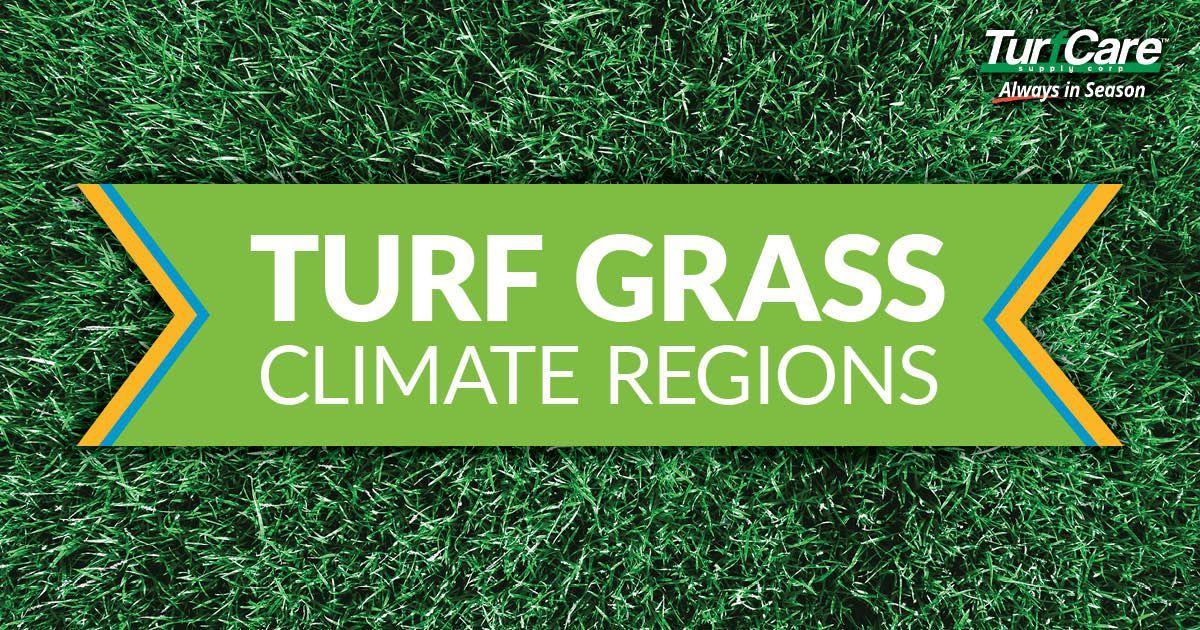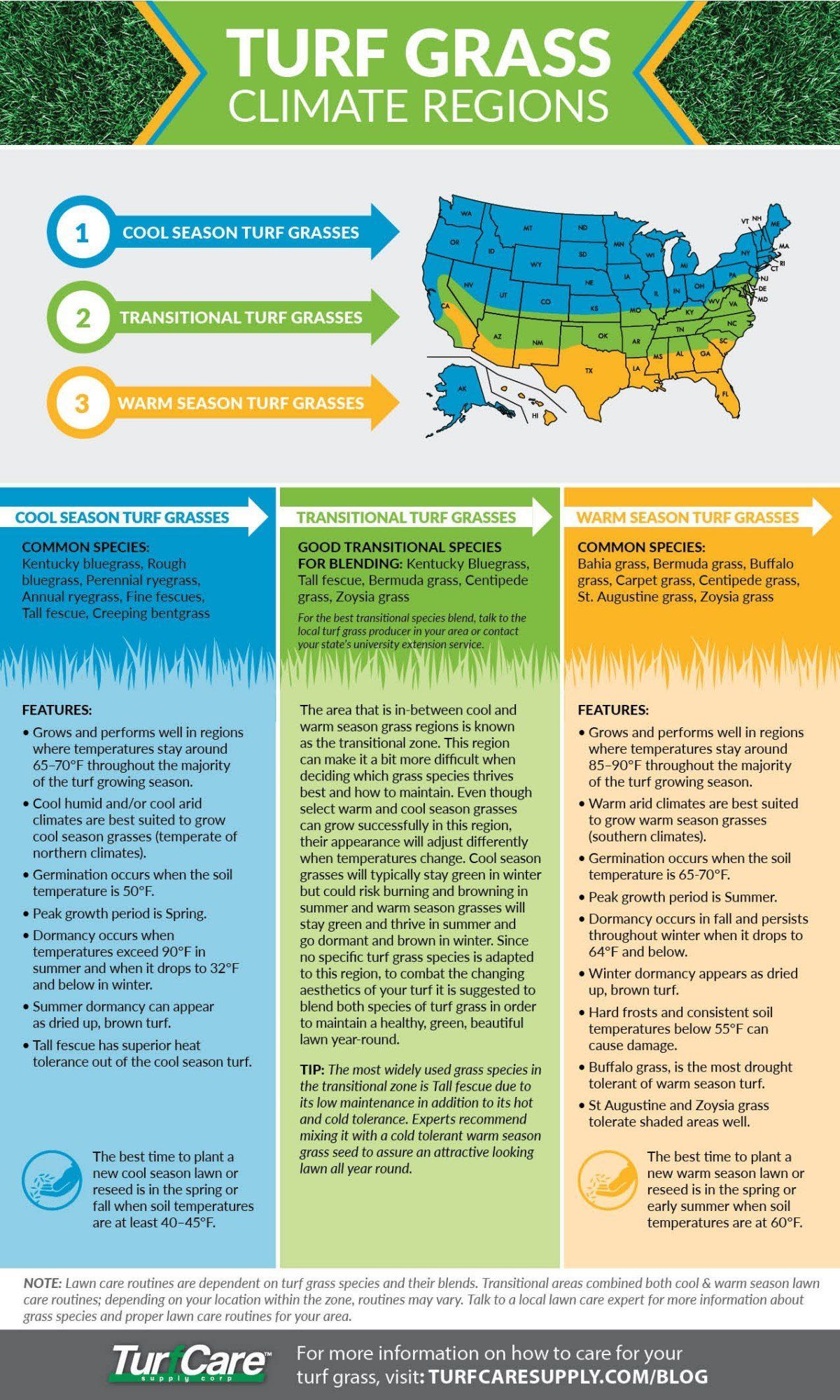Turf Grass Climate Regions
February 2, 2018

When talking turf, a person may hear the phrase, “cool season” or “warm season” grasses. However, this phrase does not actually refer to the season of growth but it describes the region where each species grows best. Both warm and cool season grass species experience the same growing seasons (spring, summer, fall and winter), but the regions overall climate and temperature throughout the year play a huge role in determining which grass species survives most successfully in each area.
Before determining a turf care program, a person must understand their climate region, the turf grass species they want to treat and the best practice for treatment. Gaining an understanding of these factors can help create a turf care program that will ensure a healthy, beautiful lawn year-round.
Please refer to the “Turf Grass Climate Region” info graphic for helpful details. Click image to enlarge:

- FERTILIZING TIPS: Wait 5-7 weeks between fertilizer & control product applications to avoid burning your lawn.
- Sweep any product that lands in the driveway, sidewalk, or street back into the lawn.
- Water in products after application to activate and reduce product loss due to volatilization.
- Review all active ingredients on product label to determine if the blend is appropriate for your specific lawn type.
Check with your local distributor for more information on grass type and proper product chemistries to use for your area.
For advice on products best suited for your region, check out these TurfCare™ recommended Regional Lawn Care Programs.
Visit TurfCareSupply.com/blog for more information on building a turf care routine. Check out these important articles to get you started:
The Turf[TECH]Report - Prodiamine: Widely Used & Effective Pre-Emergent Herbicide
Tackling Weeds in The Fall
The Turf[TECH]Report - What's the Buzz on Insecticides?
The Turf[TECH]Report - Getting the Dirt on Soil Amendments
The Turf[TECH]Report - Understanding Herbicides
Why Winterize Your Lawn
Should I Aerate?
Get the Dirt On Thatch
Want to Give Your Lawn a Summer Treatment? Lime It!
References:
https://www.domyown.com/lawn-care-schedule-a-537.html
http://plantscience.psu.edu/research/centers/turf/extension/factsheets/cool-season-turfgrasses-id
http://www.learn2grow.com/gardeningguides/lawns/typesgrasses/WarmSeasonGrasses.aspx
http://www.usna.usda.gov/Gardens/faqs/turfgrassfaq2.html
http://homeguides.sfgate.com/temperatures-grass-seed-germination-61409.html
http://www.ntep.org
http://www.landscape-america.com/grasses/transitional.html
https://www.bayeradvanced.com/articles/when-to-dethatch-a-lawn
https://www.bayeradvanced.com/articles/warm-season-vs-cool-season-grasses
https://www.gardeningknowhow.com/lawn-care/lgen/what-is-cool-grass.htm
https://www.naturesfinestseed.com/cool-season-vs-warm-season-grasses-explained
https://www.thespruce.com/what-types-of-lawn-grasses-are-there-2130979
https://www.pnfertilizers.com/whats-the-difference-between-warm-cool-season-grasses/
http://homeguides.sfgate.com/effects-ground-temperature-grass-69755.html
http://lawngrasses.com/info/climate-map.html#.WnIyha2ZP64
The TURFReport Highlights:
Additional Articles and Insights

April 18, 2025
Turf Care Supply, LLC, a portfolio company of Platte River Equity, has officially acquired Beaty Fertilizer, the industry respected Tennessee-based manufacturer and blender of custom granular and liquid fertilizers, as well as combination products. This strategic move expands Turf Care’s manufacturing footprint, adds new product capabilities, and enhances overall production capacity.

October 4, 2024
Dear Valued Industry Partners and Customers, We are pleased to announce that Turf Care Supply, LLC has acquired Agri-Nutrients, Inc. (October 1, 2024) a respected manufacturer in the turf and ornamental fertilizer industry. This acquisition marks a significant step forward in our commitment to providing you with an expanded range of innovative products, services, and industry expertise, all designed to support your business’s continued growth and success. As a valued partner or customer, you will benefit from enhanced service capabilities and an extended geographic reach, thanks to Agri-Nutrients, Inc.’s strategic facility located in the Port of Catoosa, Oklahoma. With this established presence in the Southwest and Western markets, Turf Care Supply, LLC’s expanded operational footprint will allow us to serve a broader region with greater efficiency, delivering even stronger support to help drive your business forward. We are dedicated to ensuring a seamless transition while maintaining the high standards of service you expect. If you have any questions or would like to explore how this new location can enhance your operations, please feel free to contact your account manager or our customer service team. Thank you for your continued trust in Turf Care Supply, LLC . We look forward to partnering with you as we grow together and continue supporting your success. Sincerely, Mark ManganPresidentTurf Care Supply, LLC

September 28, 2023
With a focus on providing sustainable manufacturing and reducing carbon emissions, Turf Care Supply has embraced the electric power market with the latest mobile equipment upgrades. Completed in June 2023, TCS received all deliveries of electric forklifts to all three manufacturing facilities, including Hatfield, MA, Martins Ferry, OH and Sebring, FL.

July 19, 2023
When handling fertilizers and pesticide it is important to follow suggested guidelines and prioritize safety to protect yourself, others, and reduce environmental impact. Here are some general measures to follow: 1.Read and Follow Instructions: Carefully read and understand the product labels, safety data sheets (SDS), and any accompanying instructions provided by the manufacturer. Follow all recommended guidelines, precautions, and application rates.

June 22, 2023
It’s common knowledge that applying too much fertilizer containing high percentages of readily available nitrogen and water soluble nutrients can result in burn damage to plants, but did you know that damage can still occur even if your application rate is correct? Applying the right product at the right rate, but at the WRONG time can have disastrous consequences.

August 1, 2022
When summer temperatures rise and drought conditions set in, turf quality can suffer, even in healthy turf. Turf that was green and lush during the spring can be at risk for turning brown and going dormant during the summer months. This can lead to insect and weed infestations as well as other diseases that can result in additional turf damage. Being aware of these abiotic stresses can help lawn care operators, turf managers, and homeowners take steps to mitigate the damage from these stressors.

July 28, 2022
Brunswick, OH. (April 25, 2022) – Turf Care Supply, LLC (“Turf Care” or the “Company”), the leading formulator and blender of coated nitrogen and other fertilizer products to the turf & ornamental market, is excited to announce Michael Randall as the new Chief Financial Officer (CFO). Mike Randall has previously served as the CFO for both Anchor Manufacturing and for a private investment group, The Misfud Group, LLC. Mike has also held a variety of financial positions with Shiloh Industries in Valley City, Ohio and Eaton Corporation in Cleveland. Mike received his Accounting degree from Ohio Wesleyan University. “We are very excited to have Mike join the Turf Care team. Mike’s frontline leadership and successful C level experience make him an incredible addition to our company,” said Mark Mangan, President of Turf Care. Established in 1974, Turf Care Supply is one of the largest formulators and blenders of urea products to the turf & ornamental market. Turf Care has a comprehensive product portfolio of fertilizers, combination products (herbicide/insecticide), soil amendments and enhanced efficiency fertilizer ingredients. Turf Care's products are sold to distributors and blenders serving the commercial, residential and golf end markets.

April 18, 2025
Turf Care Supply, LLC, a portfolio company of Platte River Equity, has officially acquired Beaty Fertilizer, the industry respected Tennessee-based manufacturer and blender of custom granular and liquid fertilizers, as well as combination products. This strategic move expands Turf Care’s manufacturing footprint, adds new product capabilities, and enhances overall production capacity.

October 4, 2024
Dear Valued Industry Partners and Customers, We are pleased to announce that Turf Care Supply, LLC has acquired Agri-Nutrients, Inc. (October 1, 2024) a respected manufacturer in the turf and ornamental fertilizer industry. This acquisition marks a significant step forward in our commitment to providing you with an expanded range of innovative products, services, and industry expertise, all designed to support your business’s continued growth and success. As a valued partner or customer, you will benefit from enhanced service capabilities and an extended geographic reach, thanks to Agri-Nutrients, Inc.’s strategic facility located in the Port of Catoosa, Oklahoma. With this established presence in the Southwest and Western markets, Turf Care Supply, LLC’s expanded operational footprint will allow us to serve a broader region with greater efficiency, delivering even stronger support to help drive your business forward. We are dedicated to ensuring a seamless transition while maintaining the high standards of service you expect. If you have any questions or would like to explore how this new location can enhance your operations, please feel free to contact your account manager or our customer service team. Thank you for your continued trust in Turf Care Supply, LLC . We look forward to partnering with you as we grow together and continue supporting your success. Sincerely, Mark ManganPresidentTurf Care Supply, LLC

September 28, 2023
With a focus on providing sustainable manufacturing and reducing carbon emissions, Turf Care Supply has embraced the electric power market with the latest mobile equipment upgrades. Completed in June 2023, TCS received all deliveries of electric forklifts to all three manufacturing facilities, including Hatfield, MA, Martins Ferry, OH and Sebring, FL.

July 19, 2023
When handling fertilizers and pesticide it is important to follow suggested guidelines and prioritize safety to protect yourself, others, and reduce environmental impact. Here are some general measures to follow: 1.Read and Follow Instructions: Carefully read and understand the product labels, safety data sheets (SDS), and any accompanying instructions provided by the manufacturer. Follow all recommended guidelines, precautions, and application rates.

June 22, 2023
It’s common knowledge that applying too much fertilizer containing high percentages of readily available nitrogen and water soluble nutrients can result in burn damage to plants, but did you know that damage can still occur even if your application rate is correct? Applying the right product at the right rate, but at the WRONG time can have disastrous consequences.

August 1, 2022
When summer temperatures rise and drought conditions set in, turf quality can suffer, even in healthy turf. Turf that was green and lush during the spring can be at risk for turning brown and going dormant during the summer months. This can lead to insect and weed infestations as well as other diseases that can result in additional turf damage. Being aware of these abiotic stresses can help lawn care operators, turf managers, and homeowners take steps to mitigate the damage from these stressors.



